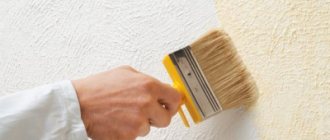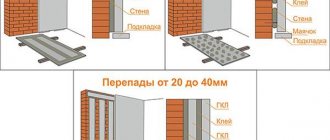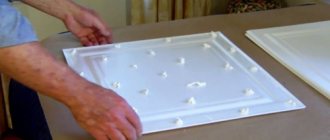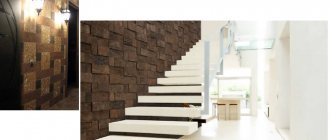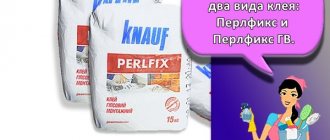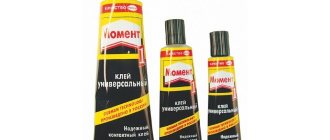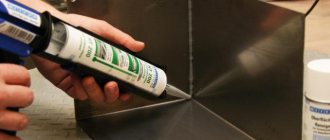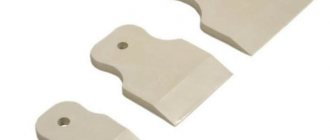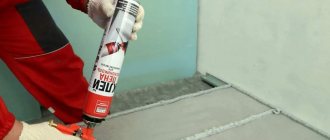Foam blocks are increasingly used in housing construction. Load-bearing walls and interior partitions are erected from them. Their use speeds up the construction process. For masonry, a special composition is used as a fastening compound - glue for laying foam blocks. It is superior to traditional mortar in many ways:
- stronger (creates a reliable connection of blocks in masonry);
- denser (preserves the thermal conductivity characteristics of building materials);
- hardens faster (up to half an hour);
- does not collapse due to sudden temperature changes;
- more economical (much less cement is required due to the reduction in layer thickness);
- more convenient to prepare (all components are in one package, all you have to do is dose the dry mixture and water);
- more resistant to moisture (polymers form a protective film on the seams).
Why glue is more practical
When using concrete mortar, the blocks absorb water, which is added in excess when preparing the cement-sand mixture. Therefore, in order to protect the surface, a protective primer must be applied to each row of masonry. The glue contains moisture-retaining additives, there is no excess water.
Saving time and money. The adhesive mixture is easier to prepare and apply. It requires much less than a traditional solution.
The layer of traditional building mixture reaches a thickness of up to 1 cm, otherwise it is impossible to hold the block securely. When dry, the seams have high thermal conductivity, and the energy efficiency of the home decreases. The costs of heating and additional thermal insulation are increasing.
When using glue, the heat-retaining capacity of the walls does not decrease. Thin adhesive connection of blocks does not imply additional costs.
Differences from cement mortar and advantages
Below is a video comparing polyurethane foam, cement-sand, mortar and adhesive mixture. Comparison of strength and consumption. True, aerated concrete blocks are used, but this does not change anything essentially. If you use glue for foam blocks, the result will be the same.
The solution is much worse. The strength is less, the consumption is high, and even the cold bridges are considerable. (The thickness of the seam when laid on a mortar is much greater than on foam or glue. And the mortar, unlike a block, does not protect against sub-zero temperatures; cold passes through easily).
Foam is similar in value to the adhesive mixture, but is more expensive.
Unlike standard cement-based masonry mortar, the adhesive mixture has a number of advantages:
- low consumption per 1 m² of surface is ensured by the fine fraction of cement and sand;
- uniform, dense masonry without loss of adhesion quality;
- the thermal insulation properties of the adhesive solution help maintain the microclimate in the building;
- glue for foam blocks does not draw water from the masonry material, which prolongs the life of the building and prevents shrinkage of the walls;
- glue for foam blocks is plastic, hygroscopic, vapor-permeable, increases the sound insulation properties of foam blocks;
- glue for foam blocks is frost-resistant, does not deform or collapse under the influence of atmospheric factors;
- preparing the adhesive solution does not require special skills and knowledge;
- all components are environmentally friendly;
- high-quality adhesive mixtures contain components that protect walls from mold and various fungi;
- in order to dilute the working mixture, there is no need to use a concrete mixer.
Multi-component structure
Glue for foam blocks is a dry mixture of Portland cement, fine quartz sand, moisture-retaining components, and plasticizers. Thanks to its complex composition, the building mixture fills all the voids.
The quality of the masonry depends on the correct ratio of water and dry mixture. If there is not enough moisture, the glue will dry too quickly; if there is too much, it will spread over the surface of the blocks.
You should pay attention to the seasonality of the compositions, it is indicated on the packaging:
- White summer glue is designed for use at temperatures from +5°C to +30°C. The finished mixture hardens within 2 hours.
- Frost-resistant glue for foam blocks is diluted with hot water (up to + 60°C), in portions - the mixture hardens within half an hour. The composition is designed for temperatures from + 5°C to -10°C and contains anti-frost plasticizers.
Progress of work on the construction of walls using glue
And now it’s time to figure it out: what’s the best way to glue foam blocks? And, more precisely, how to lay them correctly? You should start by purchasing a tool, a mixture and preparing a solution.
Preparatory work: purchasing tools, preparing the mixture
To carry out the work you will need the following tools:
- A bucket or other container suitable for mixing the mixture;
Container for mixing the mixture
- Construction level;
Level
- Square;
Square
- Drill with mixer attachment;
Drill
- Wall chaser;
Manual wall chaser
- Grater;
Grater
- Hacksaw;
Foam block hacksaw
- Rubber hammer;
Kiyanka
- Scraper bucket.
Bucket scraper
The latter is used for ease of application of the composition. Glue dispensers for foam blocks help increase construction speed and minimize consumption.
- The preparation of the mixture must be justified by the manufacturer’s recommendations posted on the product packaging.
- The amount of liquid must correspond to what is stated - otherwise, the properties of the finished solution may change, and not for the better.
- The mixture should be mixed in small portions to avoid premature hardening - that is, before the entire finished composition has been developed.
The process of mixing glue for blocks
If this happens, manufacturers do not recommend diluting the solution with water.
Technology for constructing foam block walls
When the tools have been purchased and the adhesive mixture is ready for use, you need to proceed directly to installation.
The work process includes the following stages:
- The base must be level, installation of waterproofing on it is mandatory.
- Laying starts from the highest corner, where the layer thickness will be minimal.
- The first blocks are laid out in the corners, between which a cord is stretched, which subsequently serves as a guide.
- Experts advise laying the first row on a solution. This will increase the level of adhesion to the base and the strength of the structure.
- If there is a gap between the blocks that is smaller in size than the block, the products must be cut to the required size. You can use a saw or hacksaw.
- The second, third and subsequent rows are placed on glue.
- Do not forget about the seam displacement by about 25-30%.
- When laying the first and every third and fourth row, it is necessary to carry out reinforcement (see Masonry mesh for foam blocks: which one is better to choose).
- After finishing the masonry of the walls, it is recommended to install an armored belt.
Some photos below show a gas block, but it does not differ in any way from the foam block when laid.
Start of work: laying the first blocks
Block adjustment
Applying glue
Dressing options
Foam block reinforcement
General scheme of reinforcement of walls made of foam blocks
Armored belt device
Internal walls made of foam blocks laid with glue
Finished house made of foam block
- During laying, its evenness should be controlled. The blocks are adjusted using a rubber hammer, which, having sufficient weight, if used correctly, will not damage the product.
- Subsequently, the blocks can be finished with almost any materials: plastering (see Plastering foam blocks: technology of work), installing a ventilated facade, facing with brick and much more.
- It is worth noting that with even and technically correct laying of blocks, the costs of finishing materials and work can be significantly reduced.
- For example, tiles can be laid directly on the wall, without prior plastering. And the consumption of putty, if subsequent painting is desired, will be significantly lower in the absence of differences. There are many more examples that can be given.
But how to putty foam blocks and how to stick tiles onto a foam block are topics for another article. The video in this article: “Foam blocks: what to glue and how” contains information about choosing an adhesive mixture and the work process.
Where to stop
A professional consultant will tell you which glue for foam blocks is best suited for the object. The building materials market offers products from many mixture manufacturers. The quality of the economy option does not inspire confidence; it is better to refuse such a purchase.
What to pay special attention to:
- well-known manufacturer or not (brand selection);
- seasonality of use (take into account climatic operating conditions).
Due to the optimal price-quality ratio, some brands confidently hold their place in the sales rankings.
Determining the required amount of solution
The average amount of mortar required for laying foam blocks with good geometry in one row under normal temperature conditions (from 5 to 25 degrees Celsius) is approximately 30 - 40 kilograms of mixture per cubic meter of blocks. However, in practice there are many situations that do not fit these parameters.
If there is a discrepancy between the blocks in size, the need to level out this difference using the solution leads to its increased consumption. Then the 30-40 kilograms required for single-row masonry grow into a mass of about 60 kilograms.
According to these figures, materials for making the solution are purchased. However, you should not take them from the calculation of the masonry of all the walls of the building. It is better to limit yourself to the materials for preparing the solution for the first few cubic meters of blocks. After all, the degree of their heterogeneity, as well as other conditions affecting the consumption of the mixture, can vary. Therefore, the required amount of fastening mixture can be most accurately determined only on the basis of experience in laying a wall under specific conditions.
Characteristics of adhesive for foam blocks
Volma. Suitable for porous foam concrete. Levels the masonry surface: permissible layer thickness is 5 mm. Universal: used for blocks and reinforced concrete slabs.
Titanium. Foam glue in cans. Analogous to cement adhesives. Applied in strips, it simplifies the process of building walls. Reliable. Cons: requires certain skills to apply, not recommended as a support layer - deforms under heavy load
Knauf. Contains gypsum additives. Versatile. Suitable for laying and leveling walls, installing slabs. Economical. Dries quickly during styling.
Founds Selform. Used in summer. Considered an ideal seasonal glue. Economical. Finely dispersed and homogeneous in composition.
Aeroc. The frost-resistant composition is resistant to temperature changes. The hardening period is up to an hour. Provides for leveling the block during installation.
- Technical gases. What are they?
Roofing. What are they?
- Rolled sheet metal. What it is?
The presented photos of glue for foam blocks clearly show what the packaging looks like. They can be easily found among other building mixtures. Pay close attention to the weight of the package. It can be different.
Review of manufacturers
The most popular products in the construction market today are the products of the following manufacturers:
- Volma . The leader among domestic installation adhesives for cellular concrete. Contains sand, cement, dispersion additives. Designed for seams 2-5 mm. Available in 25 kg bags.
- Titan . This is foam adhesive for foam blocks. Produced in 750 ml bottles. For installation, simply apply the product to the surface. Characterized by speed of application and reliable results.
- Knauf . Product based on gypsum and polymers. It is characterized by fast setting, strength of the seam formed and complete environmental safety. Sold in bags of 30 kg.
- IVSIL Block . Dry mixture based on cement. The advantage is the ability to make adjustments within 15 minutes after application. Available in 25 kg bags.
- Founds Selform T112 . Frost-resistant composition for winter use. The fine-grained structure allows applying layers up to 1 mm. Complete hardening after 2 hours. Sold in bags of 20 kg.
- Ceresit ST 21 . Winter glue. It is characterized by high plasticity. Available in 25 kg bags.
Necessary calculations
The consumption of glue for foam blocks is determined by the average indicators indicated on the packaging (covering a flat surface of 1 m2 with a layer of thickness specified in the instructions).
Depending on the porosity of the surface of the blocks, 15 to 30 kg of mixture is required per 1 m3 of building materials of standard sizes.
Additional costs are possible:
- if necessary, leveling defects and irregularities;
- lack of skills in working with glue.
Glue is purchased with a reserve, focusing on the labeling. The mixture is packaged in 25 and 30 kg paper packages.
Top 5 best compositions
The most widely used brands are BOLARS, KNAUF, VOLMA and PORITEL. Do not skimp on glue, because it is better to take an expensive, but high-quality product.
Glue "VOLMA"
Its components are sand, cement and good quality dispersive admixtures. Suitable for creating two to five millimeter joints, cellular concrete and for leveling bases.
"TITANIUM"
It is found on sale as foam adhesive for foam concrete blocks. They can easily replace cement. Apply linearly. With it, the product will be reliable, and the work will proceed at a fast pace.
"KNAUF"
KNAUF PERLFIX is made from gypsum along with polymer components. With it you can perfectly level the surface of the walls and glue blocks. Packaged in thirty kilogram bags.
"IVSIL BLOCK"
This product is used for grooved and non-groove materials, as well as for foam and aerated concrete blocks. Apply with a thickness of 2 millimeters. Adjustments to the product are allowed within fifteen minutes.
Experts recommend
Practitioners who use adhesive mixtures have gained some experience. Some advice from professionals.
- Profiled sheet. What is it like?
- Industrial robots. What are their advantages?
Hydranautics membranes
To ensure a homogeneous consistency, mix the solution with a mixer. It is more convenient to pour water into the mixture, and not vice versa - the risk of spillage is reduced. Strict portion control ensures the quality of the walls being built.
To ensure reliable adhesion of the masonry, the foam blocks are moistened before forming the adhesive layer. The mixture goes on smoother.
Deformed blocks in places of damage are leveled. A plane can be used for these purposes. The resulting “powder” is blown off.
It is necessary to completely fill the side seams without leaving any voids. The blocks are fitted as tightly as possible.
Glue is used from the second row and above. The recommended height is 30-40 cm above the foundation. The beginning of the wall is done using traditional mortar.
The best penetrating waterproofing for concrete - selection criteria, application rules, storage featuresReinforced concrete columns
- Penetrating waterproofing for concrete
What is the consumption per cubic meter of base
Data on the parameters of the room that you are going to cover with foam concrete are in the design documentation, or you can calculate it yourself.
First, you need to calculate the total volume in cubes, multiplying the perimeter of the wall to be pasted by the approximate thickness, and from the resulting number subtract the volume of the window, door, interior vaults and interfloor ceilings.
So, it is necessary to determine the volume of the wall, but this is not an easy task. As the practice and experience of craftsmen shows, one cubic meter will take approximately 15-23 kilograms of adhesive mass.
How to lay foam blocks on glue with your own hands
The laying process is not complicated if you follow certain rules. To get started, it is important to check the quality of the glue and prepare a small portion. Every four rows, the load-bearing wall is reinforced to provide rigidity. All irregularities are smoothed out with an additional layer of glue.
To form a layer, use a spatula with teeth. The mixture is applied to the top and side of the foam block. The remainder is returned to the bucket. After laying the lubricated block, it is compacted with a rubber hammer.
Areas of use of adhesive mixtures for concrete blocks
As a rule, adhesives find their use in almost all industries that often deal with foam concrete.
In particular, when building private houses, cottages, bathhouses, garages and other similar structures, experts advise using a special adhesive.
Like aerated concrete, foam concrete is also widely used for the construction of partitions and load-bearing walls, and it also performs soundproofing and insulating functions. In addition, with this material you can add additional floors to the house.
